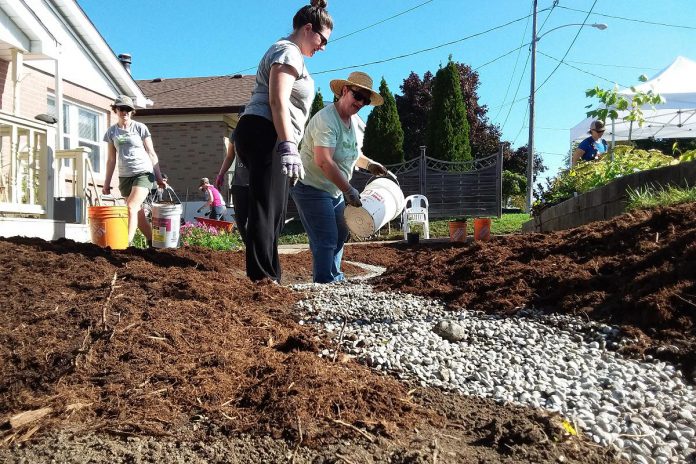
When it comes to taking climate action, there are a number of significant actions that all residents, and especially homeowners, can take to reduce their impact and adapt to future changes in our climate. GreenUP will be focusing on these opportunities for action in a series of Climate Action at Home articles throughout 2022. This first article in the series is about rain gardens.
I am fed by water, but often dry. I am urban infrastructure that you — yes you — can DIY. What am I?
If you guessed a rain garden, then you are correct.
Rain gardens are bowl-shaped depressions, full of plants. When it rains, these gardens hold and absorb the stormwater or runoff from nearby hard surfaces, like roofs or driveways. Rain gardens replenish soil moisture, remove pollutants, and restore groundwater aquifers.
Rain gardens reduce the amount of stormwater that would otherwise head straight for our urban storm sewers, where it causes all kinds of problems.
“Currently, only 25 per cent of the City of Peterborough’s stormwater is filtered for pollutants before entering natural waterways, such as the Otonabee River or Jackson Creek,” explains Curtis Mei, the city’s stormwater systems coordinator.
“When it rains, urban runoff (stormwater) carries sediment and pollutants from vehicles, fertilizers, road salt, animal waste, and grass clippings into these waterbodies, which pollutes natural habitat and our source of clean drinking water,” Mei adds.

Stormwater sewers can also become overwhelmed during heavy rain events, which can cause localized flooding.
That’s why many municipalities, including Peterborough, are moving toward greener and more decentralized strategies for managing stormwater. Such approaches only work if individual property owners reduce the amount of runoff they create.
Rain gardens are a key component of this new approach. The more rain gardens there are, the greater the cumulative benefit. If you want to take climate action at home by installing a rain garden, there are programs and people to help you. The City of Peterborough introduced a Rain Garden Subsidy in 2020 to increase the number of rain gardens within the city.
Sounds great! Where do I start?
Dip your toe into rain garden literature and it’s easy to become overwhelmed. Inlets? Outlets? Ponding depth? Math?! No one said there would be math!
While there are technical elements that are important to get right, a rain garden is also an expression of your personal style. There are many shapes, sizes, and styles of rain garden.
Even non-gardeners can design and install a beautiful, functional, low-maintenance rain garden with support from GreenUP and the City of Peterborough.

Interested homeowners should begin by reviewing the information oat Rain Garden Subsidy page on the city’s website and in the application guide.
Next, there is a eligibility form that determines whether your property is suitable for a rain garden. The form also estimates the amount of subsidy you will receive, based on the size of your roof and proposed garden footprint.
Once you are pre-approved, GreenUP staff will support you through the design and full application process.
In 2022, the City of Peterborough is making changes to the program to provide homeowners with additional support.
The subsidy amount is being increased from a maximum of $500 to a maximum of $1,000 per garden, to cover a greater proportion of the costs associated with designing and installing a rain garden.
GreenUP and the City of Peterborough are also producing four short instructional videos to replace the two-hour workshop offered in previous years. The videos will be available in late summer 2022. (Applicants who wish to apply for a subsidy this spring will be provided with a recording of last year’s workshop instead.)

Finally, applicants can take advantage of up to two site visits by GreenUP staff during the design and installation process.
One of these visits is required, and must take place during the rain garden’s construction. The other visit can be used at a time of the applicant’s choosing, for additional advice on garden design, application support, or plant selection.
Subsidies are limited and are awarded on a first-come, first-serve basis. What are you waiting for? You can direct questions about the program to Hayley Goodchild at hayley.goodchild@greenup.on.ca or by phone at (705) 748-3238 ext. 213.


























